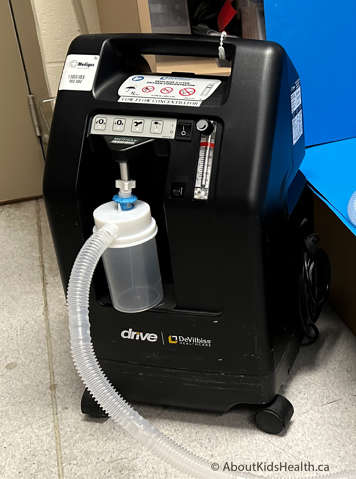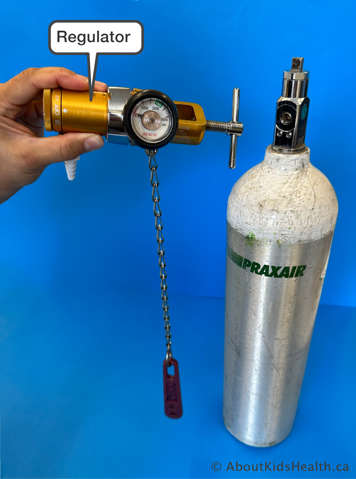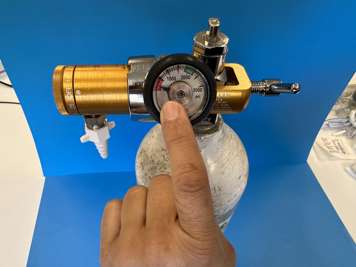By the end of this section, you will be able to:
- identify the different types of home oxygen therapy systems
- describe safety considerations when using each type of home oxygen therapy system
There are three types of home oxygen therapy systems:
- Concentrator (stationary or portable)
- Oxygen cylinder
- Liquid system
Concentrator (stationary or portable)


- A concentrator is a machine that makes oxygen by taking room air and separating the oxygen to administer it.
- It can be powered by electricity (stationary type) or a battery (portable type for traveling).
- It does not need to be replaced or refilled regularly because it makes oxygen from the air in the room.
- A stationary concentrator is often placed in the home, along with back-up oxygen cylinders in case of a power failure, which could cause the concentrator to stop working.
- A portable oxygen concentrator can be used as a short-term solution when travelling.
- A concentrator can be connected to humidification equipment while delivering oxygen through the same tubing.
Safety considerations when using a concentrator:
- Do not put the concentrator near anything that could block the intake of air, such as curtains or loose blankets.
- Keep the concentrator away from sources of heat, such as fireplaces and heaters.
- Ensure the concentrator is directly plugged into a power outlet, do not use an extension cord.
- Ensure the inlet filter is clean.
Oxygen cylinder (compressed gas)

- Oxygen cylinders are aluminum or steel tanks that contain compressed oxygen gas. A full tank pressure is 2200 pounds per square inch (psi).
- Oxygen cylinders come in a variety of sizes: larger cylinders (sizes E and H) are used in hospitals or as a back-up to a concentrator in the home. Smaller cylinders (e.g., C and D sizes) can be used in the home, for short outings or when travelling.
- Oxygen cylinders can deliver oxygen at different levels without using electricity; therefore, it can be used as back up to a concentrator if there is no power.
- Because it is portable and does not require power, cylinders can be used when travelling with your child.
- It is important to remember that cylinders contain a limited amount of oxygen. It is important to know the size and flow rate required for your child’s oxygen prescription when travelling so you know how long the tank will last. For example, the cylinder will run out quickly if used continuously at a high flow rate. Always ensure you have enough supplemental oxygen for your child while travelling outside of the home. Ask your medical vendor how long one cylinder will last, based on the flow rate prescribed for your child.
Safety considerations when using a cylinder:
- Do not leave a cylinder in a hot car.
- When travelling, the child must have the cylinder with them. Do not place in car trunk.
- Place the cylinder flat on the floor.
- Keep oxygen delivery devices in well-ventilated areas and never cover them with a cloth or other material.
- Do not allow smoking or vaping in the car and near the cylinder.
- A cylinder should never be free-standing upright without being secured to a wall or in a cart.
Regulator

Regardless of the size of the cylinders, each comes with a regulator. A regulator is a device that fits over the oxygen tank/cylinder to control the delivery of oxygen flow out of the tank. Regulators have flow control knobs to provide oxygen flow in litres per minute (LPM). Regulators vary in how much LPM flow they can provide. Some only go up to 1 LPM while others may have settings that allow flow up to 8 or 10 LPM. The type of flow meter provided by the respiratory vendor will depend on how much oxygen your child needs.
Pressure gauge

Each flow meter has a pressure gauge. The gauge tells you how much oxygen is left in the tank, using the measurement of pounds per square inch (psi). When the cylinder is full, the gauge will read 2200 psi. When empty, it will read 0 psi. Have a backup tank ready when the gauge goes below 500 psi.
The respiratory vendor will provide you with a schedule of when they are delivering new full cylinders and picking up the empty ones.
Some vendors offer cylinder re-filling or home-fill systems. If your child requires more frequent use of tanks/cylinders, please contact the vendor to see if this is an option.
How to change a regulator from an empty tank to a full tank

Before you change a regulator from an empty tank to a full tank, review the following safety points:
- Ensure the oxygen cylinders are full. If the oxygen level is running low (less than 500 psi), locate the back-up cylinder and/or call the medical vendor for replacement as soon as possible.
- When switching to a new cylinder, remove the regulator from the empty cylinder and attach it to the full cylinder. The steps for this procedure are demonstrated in the images below.
- When the oxygen cylinder is not in use, ensure that it is turned off and stored appropriately (e.g., in a well-ventilated area, away from sources of heat or fire).
For more information on oxygen and regulators, review the following AboutKidsHealth articles on oxygen therapy, giving oxygen to your child and travelling with oxygen therapy.
To change the regulator from an empty tank to a full tank, do the following:
- Turn off the empty tank using the tank key. Turn the key in a clockwise direction.
- Use the key to loosen the crank. Then, continue to loosen the regulator by turning the crank manually until the regulator can come off.
- Locate a new tank and remove any plastic covering on the neck of the cylinder.
Place the regulator onto the new tank. Align the pins and make sure there is a washer on the larger round part.




Tighten the crank well. Use the cylinder key to help, if needed.


Open the tank, turning the cylinder key in a counter-clockwise direction.


-

Verify the tank pressure.
- Turn off the tank by turning the cylinder key in a clockwise direction.
'Bleed' the regulator by turning on the flow; do this by turning the flow control knob to the highest number. See below for more information on bleeding the regulator.


-

Turn the flow control knob to OFF.
- Store your oxygen cylinder safely, according to the instructions from your health-care team and the medical vendor.
What does 'bleeding off the regulator' mean?
'Bleeding off the regulator' means to release the remaining oxygen within the cylinder. When the tank is not being used, it is best to turn it off to avoid any oxygen from leaking. In addition, if you don’t bleed the regulator, it will continue to display a pressure on the gauge. If someone requires oxygen and the regulator was not properly bled out by the previous person, the tank may be forgotten to be turned on. In this case, the patient will only get the small amount of oxygen that was remaining in the regulator only. Bleeding off the remaining oxygen within the cylinder before removing regulator and anytime you are checking the tank pressures can prevent such incidence.
Liquid system

- A liquid system uses oxygen that has been cooled and compressed until it becomes a liquid.
- The liquid oxygen is kept in large stationary containers called reservoirs.
- Reservoirs do not require electrical power.
- The liquid turns into gas before it leaves the reservoir and remains a gas when it is breathed in.
- The large liquid reservoirs must be refilled regularly by your medical vendor.
- A liquid oxygen system has two main advantages:
- It generally lasts longer than an oxygen cylinder.
- A smaller portable liquid oxygen reservoir (refillable container) can be refilled using the large liquid reservoir for travelling.
- The biggest disadvantage of a liquid system is that the oxygen will eventually warm up and evaporate even if it is not used. For example, if you are away from home for a long time, your medical vendor may need to refill the liquid system reservoir when you return home as the oxygen may have fully evaporated.
- As with oxygen cylinders, how long the portable oxygen tanks last will depend on your child's oxygen flow rate, as prescribed by their health-care team. Ask your medical vendor how long one tank will last, based on the flow rate prescribed for your child.
Safety considerations when using a liquid system
- Ensure all connections are airtight. If not properly closed or connected, the unit can become frozen, preventing proper refilling.
- Since the liquid oxygen is stored at extremely cold temperatures, it can burn the skin if exposed.
- Keep the units in an upright position at all times.
Safely traveling with your child’s oxygen
- Ensure the portable oxygen system you are using is functioning properly and not leaking.
- If you are using a portable oxygen concentrator, ensure the battery is fully charged before leaving home.
- If you are using a portable liquid system, ensure it is store upright.
- Keep the vehicle’s air temperature below 51 degrees Celsius.
- Oxygen systems should NOT be stored in the trunk of a vehicle.
- Do not smoke or vape in the vehicle, around oxygen systems or while using oxygen.
- Do not use or store any flammable products in the vehicle.